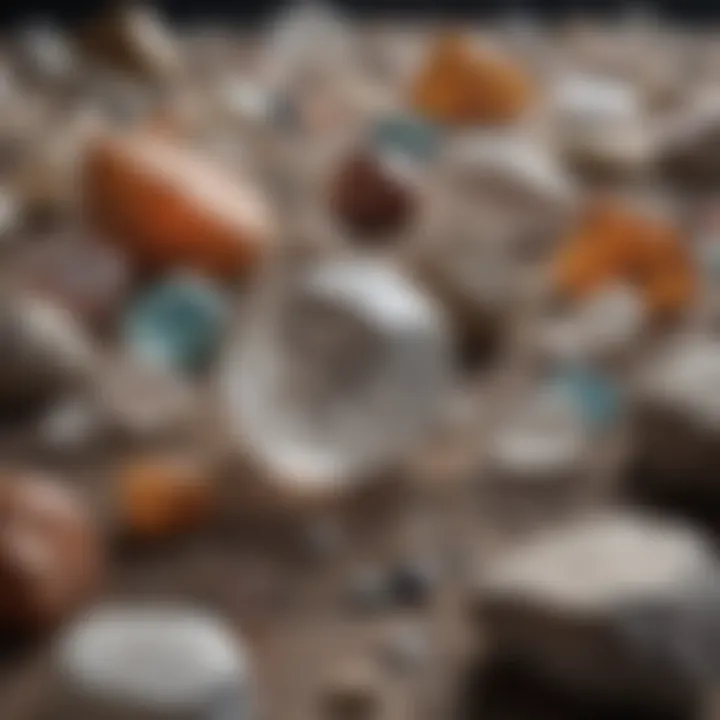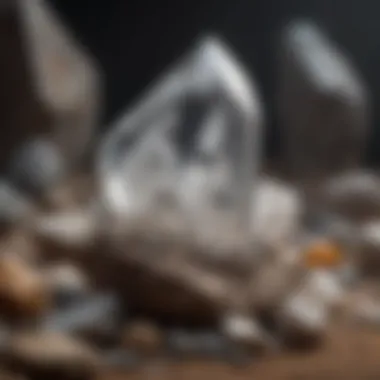Understanding Quartz: Identification and Significance


Intro
The world of quartz is a labyrinth of colors, clarity, and forms, each specimen telling a story of geological processes over millions of years. For both seasoned rock hounds and curious novices, understanding quartz identification is more than just a hobby; it's a gateway to appreciating nature’s design and history.
Quartz, a common yet complex mineral, comes in a multitude of varieties, each with unique properties and allure. From the striking amethyst to the ubiquitous clear quartz, the subtleties that differentiate these forms often escape the untutored eye. This guide serves as a thorough resource for those wishing to navigate the multifaceted terrain of quartz identification, breaking down the essential elements that play a crucial role in recognizing and appreciating this wonderful mineral.
We'll dive into the techniques for identifying quartz, clarify misconceptions that might cloud one’s understanding, and highlight the significance of quartz in the geological timeline. Through a methodical approach, featuring tips grounded in both science and practical experience, enthusiasts can refine their skills and deepen their appreciation for this remarkable mineral.
Featured Collectible of the Month
Overview
This month, we spotlight rose quartz, the gentle pink variety of the mineral that has captivated collectors and crystal enthusiasts alike. Often associated with love, healing, and tranquility, rose quartz is not only visually striking but also rich in cultural meaning. Its soft hue ranges from pale pink to a deeper, more vibrant tone, making it a standout in any collection.
Historical Significance
Historically, rose quartz has been cherished for its purported metaphysical properties. Ancient civilizations, from the Egyptians to the Greeks, believed in its power to bring love and harmony. Archaeological findings suggest that rose quartz was used as a gemstone in jewelry and ornaments dating back thousands of years. This historical significance adds an extra layer of allure for those who treasure the stories woven into their quartz specimens.
"Quartz may be abundant, but its variations embody the rich tales of earth."
Understanding the historical context of quartz can enrich the collecting experience, encouraging deeper connections with each piece.
Identification Techniques
Visual Characteristics
To the untrained eye, quartz might seem uniform, but its diversity reveals itself under scrutiny. Here are key visual traits to focus on when identifying quartz:
- Color: Depending on mineral inclusions and environmental factors, quartz comes in colors like clear, amethyst (purple), citrine (yellow), and smoky (brown to black).
- Transparency: This can range from completely transparent to opaque. Clear quartz exhibits a glassy luster, while others like milky quartz appear cloudy.
- Crystallization: Look for hexagonal shapes and pointed terminations, common in quartz crystals.
- Inclusions: Many quartz varieties contain unique inclusions like rutile or iron, which can greatly enhance their character and identification.
Resources for Identification
For those eager to expand their knowledge, several resources can aid in quartz identification:
- Books: "The Rockhound's Handbook" offers a comprehensive look at rock and mineral identification.
- Online Forums: Websites like Reddit present active discussions where collectors share insights and tips.
- Local Museums: Many geological or natural history museums have programs or resources to help budding collectors understand quartz and its many forms.
- Online Databases: Useful sites such as Wikipedia and Britannica provide detailed information about various quartz varieties and their characteristics.
By employing these techniques and leveraging available resources, enthusiasts can enhance their ability to identify and appreciate quartz specimens, ultimately fostering a deeper connection to this remarkable mineral.
Understanding Quartz: An Overview
Quartz, a mineral with a myriad of uses and significance in both nature and human culture, commands attention in the realms of geology and mineralogy. Understanding quartz is not merely an academic pursuit; it is essential for rock and fossil collectors who strive to enhance their collections with authenticity and knowledge. This article delves into the essence of quartz, aiming to unravel its complexities and provide a solid foundation for identifying various types and forms.
The Importance of Understanding Quartz
When collectors embark on their quest for unique specimens, they must first grasp the nature of quartz. The insights gained here help prevent costly mistakes when purchasing or trading specimens. Many minerals can resemble quartz. Without a discerning eye, a collector might be led astray, acquiring a mimic instead of a genuine quartz variety. Knowledge of quartz’s defining traits can uphold the integrity of one’s collection.
Moreover, quartz's versatility means it plays a role in several industries, ranging from electronics to decorative art. Recognizing the qualities of quartz not only enriches a collector's experience but broadens their appreciation for its applications in everyday life.
Historical Significance
The history of quartz can be traced back to ancient civilizations, which revered its properties. In many cultures, quartz has been associated with healing and spiritual practices. The Greeks believed it to be ice that had frozen so deeply it could not melt, while ancient Egyptians used it in amulets and for decoration.
Today, quartz continues to capture the interest of scholars and enthusiasts alike. Many museums showcase stunning specimens, often highlighting the historical artifacts that feature quartz. This mineral isn't just an object found in the earth; it is a testament to human artistry and connection to the natural world.
Types of Quartz
Understanding the varieties of quartz is crucial for any collector or enthusiast. The diversity in this mineral mirrors the intricacies of its chemistry and geology, enhancing its allure. Each type of quartz carries its unique characteristics that make identification more than just a science; it is an exploration of nature's artistry. Knowing the differences not only aids in collecting but also enriches the appreciation of what each gemstone embodies.
Common Varieties
Clear Quartz
Clear quartz stands out as the quintessential form of this mineral, often referred to as the "master healer." What sets clear quartz apart is its remarkable clarity, making it a popular choice for numerous applications—from decorative pieces to spiritual uses. This variety is composed primarily of silicon dioxide and features a hexagonal crystalline structure that gives it its distinct appearance.
One unique aspect of clear quartz is its ability to amplify energy. Collectors often favor it for this reason, using it alongside other stones to enhance their properties. However, its wide availability means it can sometimes be overlooked for more colorful variants.
- Advantages: Highly versatile, aesthetic appeal in its simplicity.
- Disadvantages: Commonness can lead to undervaluation in collection.
Amethyst
Amethyst, with its captivating purple hue, holds a special place in both metaphysical circles and in collectors' hearts. The color originates from iron impurities and the way light interacts with them, resulting in shades ranging from light lavender to deep violet. This gemstone has a historical significance as well, once prized by royalty and often used in regal regalia.
Collectors appreciate amethyst not only for its beauty but also for its reputed calming properties. The vibrancy of its color makes it a standout piece in any collection.


- Advantages: Striking appearance, essential in both metaphysical and gem collections.
- Disadvantages: Can vary widely in quality, leading to potential confusion.
Citrine
Citrine, a yellow to brownish variety of quartz, is known for its sunny and optimistic coloration. The presence of trace iron within the crystal structure brings about those delightful warm hues. It's often associated with prosperity and abundance, making it a favorite for those who appreciate both aesthetics and meaning behind their stones.
Citrine is also recognized for its durability, making it suitable for daily wear in jewelry. It is relatively less common in nature, which can make high-quality pieces more valuable.
- Advantages: Wearability and symbolic significance, appealing appearance.
- Disadvantages: Often misidentified because of its resemblance to heat-treated amethyst.
Smoky Quartz
Smoky quartz, characterized by its rich brown to black tones, is a rather captivating variety that evokes the earthy elements of nature. The color is attributed to natural radiation and aluminum impurities in its crystalline form. Its deep color gives a sense of mystery, making it a favorite among collectors.
This variety is often associated with grounding energy and is used in various spiritual practices. In terms of durability, smoky quartz is resilient, which enhances its desirability for use in jewelry without significant risk of damage. However, its darker tones can sometimes obscure internal features that help in accurate identification.
- Advantages: Grounding properties, durability, aesthetic appeal.
- Disadvantages: Colorations can mask clarity and internal patterns commonly used in identification.
Rare Forms of Quartz
Understanding rare forms of quartz introduces collectors to unique pieces that tell their own distinct stories.
Rose Quartz
Ah, rose quartz—the stone of love, carrying a gentle pink essence that resonates with many seekers of emotional healing. The delicate blush of rose quartz is influenced primarily by titanium or manganese impurities within the silicon dioxide matrix. This variety is highly sought after not just for its soothing visual appeal but also for its perceived soothing properties.
Collectors cherish rose quartz for its romantic aesthetic, but its popularity also encourages lower-grade options in the market.
- Advantages: Symbolizes love and compassion; popular among collectors.
- Disadvantages: Quality varies significantly, often leading to confusion in authenticity.
Tourmalinated Quartz
Tourmalinated quartz is a unique blend, showcasing black tourmaline inclusions within clear quartz. This distinctive appearance results in a compelling contrast that elevates its aesthetic value. It combines the protective qualities of tourmaline with the versatility of quartz, making it quite fascinating for collectors interested in both minerals.
Due to its dual nature, it is believed to provide grounding while enhancing clarity of thought. Its stunning visuals earn it a place in both crystal healing and as an ornamental piece.
- Advantages: Combines benefits of quartz and tourmaline, visually striking.
- Disadvantages: Can be misidentified as less desirable forms of quartz with inclusions.
Rutilated Quartz
Rutilated quartz features needle-like inclusions of rutile that can appear golden, silver, or red, offering a kaleidoscope of beauty within a single stone. This striking element brings a vibrant burst of energy that attracts collectors who appreciate the interplay of inclusions with the transparent quartz body.
The presence of rutile is said to give rutilated quartz amplifying properties, making it a popular choice among crystal practitioners. Plus, no two pieces look alike, adding to its allure for unique collections.
- Advantages: Uniqueness of each piece, amplifying properties; excellent for both aesthetic and metaphysical purposes.
- Disadvantages: Higher cost due to rarity, may be misidentified without careful examination.
Understanding the various types of quartz unlocks a world of exploration and appreciation for what nature has to offer. By recognizing these subtle differences, collectors can enhance their collections and deepen their knowledge of this fascinating mineral.
Quartz Identification Techniques
Understanding quartz identification techniques is crucial for anyone diving into the world of mineralogy or seeking to build a quartz collection. These techniques are not simply tools; they are essential methods that allow collectors to distinguish between various types of quartz and to appreciate their unique characteristics. Misidentifications can lead to significant errors in categorizing quartz specimens, which in turn might mislead both collectors and researchers alike. Therefore, grasping these identification methods—spanning from physical characteristics to geological context—will improve both the quality of the collection and the collector's overall appreciation of these remarkable minerals.
Physical Characteristics
Color Variations
Color variations in quartz are a standout feature that significantly aids in identification. Different types of quartz can present an array of colors, ranging from the crystal clear of popular varieties like Clear Quartz to the rich purples of Amethyst and warm yellows of Citrine. The hues emerge due to diverse impurities or the physical state of the quartz during formation.
A key characteristic of color variations is their distinctiveness—no two pieces of quartz display exactly the same coloration. This fact alone makes them a beneficial focus for enthusiasts aiming to refine their identification skills. Additionally, understanding the formation process allows one to appreciate how environmental factors influence color, pushing collectors to dive deeper into the geological stories behind their specimens. However, the subjectivity tied to colors can present challenges, as lighting conditions may alter perceived colors, which could lead to misjudge quartz types.
Transparency Levels
Another crucial physical characteristic is transparency levels. Quartz can be completely transparent, translucent, or opaque, depending on its formation conditions and environmental factors during crystallization. This aspect plays a direct role in how one might categorize a specimen. For example, while Clear Quartz is sought after for its clarity and aesthetic appeal, certain opaque varieties may carry specific identifiers that inform collectors about their likely origins.
The importance of transparency levels lies in their consistency across various quartz forms. Transparency makes it easier to spot inclusions and other distinguishing factors. However, a challenge arises when one encounters variations due to inclusions, further complicating identification efforts.
Crystal Structure
The crystal structure of quartz—from the classic hexagonal appearance to its prismatic shapes—is vital for identification. Different quartz varieties, while often sharing common traits, exhibit variations in their structures influenced by factors such as the presence of inclusions or the surrounding minerals during growth. Collectors can use these characteristics to differentiate between similar-looking quartz types.
The key element of crystal structure is its reliability; it holds true regardless of color or transparency. This makes it a popular focus for serious enthusiasts and geologists alike. However, it should be noted that while structure aids in identification, it often requires closer inspection, sometimes involving tools, to accurately classify.
Chemical Composition


Determining Purity
Determining the purity of quartz is crucial too. The chemical composition can reveal a lot about a specimen, primarily focusing on silica content, which constitutes around 99% of pure quartz. For collectors, identifying the purity is important as it sets the stage for understanding the overall quality and classification of the quartz.
A key characteristic of determining purity is clarity; impure quartz may exhibit colorations or haze, directly affecting its market value and desirability. It is a beneficial criterion because higher purity levels are often sought after in both collectors’ circles and jewelry applications. One potential downside, however, is that determining purity typically requires laboratory analysis—a step that may deter casual collectors or those working with limited resources.
Identifying Impurities
Identifying impurities in quartz specimens can significantly affect how collectors perceive value, especially in rare quartz forms. These impurities may given rise to unique colors or characteristic features that set a quartz piece apart. Often, a collector may find themselves in possession of a piece with inclusions like hematite or chlorite, enriching its visual appeal.
The unique feature of identifying impurities is that it often leads to unexpected discoveries. Finding out what contributes to the quartz’s character can be rewarding and informative. The challenge comes in understanding how these various inclusions impact the specimen’s integrity or commercial value, which might not always be clear-cut.
Geological Context
Formation Environments
The formation environment of quartz is a topic worth exploring. Quartz forms under specific conditions—often in igneous, sedimentary, or metamorphic environments. Understanding these can grant collectors insight into the geological history of their specimens, thus adding an additional layer of appreciation during identification.
A primary characteristic is the relationship between formation conditions and quartz type. For example, quartz found in volcanic regions may differ in purity and crystallization patterns compared to quartz from sedimentary deposits. The benefit of acquiring this knowledge is significant, as it enhances a collector's ability to contextualize their pieces within broader geological narratives. Yet this approach involves thorough research, which might require time and access to geological discussions.
Associated Minerals
Associated minerals play a vital role in understanding quartz. Often, quartz forms alongside other minerals, and recognizing these can help in pinpointing the origin and type of quartz. Collectors might find quartz amongst feldspars, micas, or iron-bearing minerals, each contributing to the overall properties observable in a specimen.
The key characteristic of associated minerals is their potential to inform about a quartz specimen's formation environment. This can prove a beneficial identification technique, as certain combinations of minerals are indicative of specific geological processes. However, this method can require a keen eye and familiarity with mineral associations, which may pose a challenge for newer collectors.
Common Identification Challenges
Identifying quartz can be a tricky business, especially for those just getting their feet wet in the world of minerals. While quartz is abundant and comes in a variety of forms, it also comes with its fair share of challenges. Misidentification can lead not only to confusion among collectors but also skew the understanding of geological contexts and valuation. This section will outline some common pitfalls in quartz identification.
Misidentification Cases
Confusion with Mimic Minerals
When it comes to quartz, one of the biggest headaches for rock collectors is what we call mimic minerals. These are often minerals that look a lot like quartz but are not. For instance, certain types of calcite can be clear, giving them a quartz-like appearance. This resemblance poses quite the conundrum when trying to catalogue one’s collection.
The key characteristic that makes mimic minerals particularly challenging is their visual similarity to quartz under natural light. Take for example scolecite, which can easily confuse an untrained eye. The clarity, luster, and even hardness can draw parallels, leading to misidentification.
However, understanding the unique features of these minerals can help collectors avoid mistakes. For instance, while quartz has a hardness of 7 on the Mohs scale, calcite only sits at 3. This appreciable difference in durability can be a handy pointer for collectors.
Advantages: Spotting these mimics in advance can save a collector a lot of frustration. Plus, it pushes enthusiasts to delve deeper into mineralogy, thereby expanding their knowledge base.
Disadvantages: The drawback is that if collectors can’t differentiate them properly, they might inaccurately evaluate their collections in terms of worth and significance.
Uncommon Growth Patterns
Another roadblock that comes up in quartz identification pertains to uncommon growth patterns. Some quartz specimens exhibit growth that deviates from the standard crystal formation. These odd formations can arise due to environmental factors, like temperature fluctuations or the presence of other minerals. A good example would be hollow quartz crystals, which might lead someone to think they have a unique find while actually being a natural aberration.
The fundamental characteristic of uncommon growth patterns is that they can change the appearance quite drastically. Sometimes you get quartz that looks needle-like or even fibrous— far from the standard hexagonal shape. This can be a two-edged sword.
On the upside, identifying these unusual patterns can be an exhilarating experience, marking the discovery of something unique. On the flip side, collectors may misinterpret these anomalies as something entirely different, which can lead to mislabeling in their collections.
Advantages: Recognizing these atypical forms can enrich a collector’s experience and provide stories to share. Disadvantages: However, they can also introduce a level of complexity that muddles the identification process if one isn't well-versed in the specifics.
The Role of Samples
Moving on, let’s discuss the crucial role that samples play in the identification of quartz specimens. A sample can help serve as a beacon for distinguishing unique properties and ultimately enhance the accuracy of identification efforts.
Sample Size
The size of the sample is a significant factor when it comes to accurate identification. A larger sample allows for a more comprehensive assessment of key features like color, luster, and internal characteristics. For instance, a small chip of quartz may not reveal its inclusions or growth habits, making it nearly impossible to identify correctly.
An advantage of having a sizeable sample is that it can give a clearer picture of what you are working with. Collectors can examine the crystal structure, purities, or impurities in detail, which is essential for precise identification. However, the downside is that larger pieces may alter the collecting experience and cost, especially for rarer varieties.
Sample Condition
Not to be left behind, the condition of the sample can either assist you or block your path to clarity. A pristine specimen will provide far more identifying characteristics than one that’s weathered or damaged. For example, scratches or chips can obscure signs of growth or other key characteristics.
Hence, the state of a quartz sample becomes a vital piece of evidence in the identification process. If a collector comes across a pristine quartz cluster, they might be able to study and identify defined faces and well-formed growth patterns easily.
Ultimately, while a badly chipped piece may yield less useful information.
Advantages: Understanding the conditions leading to the preservation of quartz can shed light on its geological history.
Disadvantages: On the other hand, a compromised sample can lead to misleading conclusions and potentially rob the collector of a valuable identification opportunity.
Overall, while common identification challenges can seem daunting, awareness and understanding of these hurdles can empower collectors, improving their experience in the fascinating world of quartz.
Practical Tips for Collectors


When diving into the world of quartz, knowing how to recognize and classify these minerals is fundamental. Practical tips for collectors not only heighten one’s skills but also enhance the overall experience of collecting quartz specimens. For both novices and seasoned enthusiasts, these insights provide a playbook for effectively identifying various quartz types, ensuring that the pursuit remains engaging and educational.
Field Identification Strategies
Using a Hand Lens
A hand lens, or magnifying glass, can be invaluable in the field. Its primary role is to magnify the mineral's surface, revealing details that the naked eye might miss. This tool allows collectors to inspect color variations, inclusions, and any unique crystal formations that might distinguish one piece from another.
On the other hand, using a hand lens requires some technique. Not all hand lenses are created equal; a poor quality lens can lead to frustration rather than clarity. Therefore, collectors should invest in a good loupe that provides clear images without distortions.
One key characteristic of a hand lens is its portability, making it a favored choice for collectors hiking through rocky terrains or wandering in mineral-rich areas.
Field Guides and Resources
Field guides are another crucial asset for serious collectors. These comprehensive books often depict various quartz types with vivid illustrations alongside essential information for identification. Weights, color gradations, and striations – all described in these guides – can simplify the identification process.
A unique feature of these resources is the local focus; many guides cater to specific regions, helping collectors understand what they might find in their backyard versus further afield. However, relying solely on a single guide can be limiting, as they often encapsulate only a segment of the quartz business. Collaborating with other enthusiasts or joining local clubs can provide an even broader range of insights and experiences.
Lab Analysis Techniques
Microscopy
For those who wish to delve deeper into quartz identification, microscopy becomes the go-to method. This technique allows for a detailed exploration of the mineral's structure on a microscopic level. Whether one is investigating the internal inclusions of rutilated quartz or examining the growth patterns in smoky quartz, microscopy can offer clarity in classification.
The distinct advantage of utilizing microscopy is the depth of detail one can attain. Observations at this level not only enhance identification accuracy but also provide a deeper appreciation of the complexities within each specimen. However, it does come with the hurdle of needing access to specialized equipment and some knowledge regarding its operation.
X-ray Diffraction
X-ray diffraction represents another advanced technique for quartz identification. This method is not merely focused on visual characteristics; rather, it examines the mineral's crystalline structure. By analyzing how X-rays diffract through a quartz sample, one can determine its specific mineral phase and gather data on impurities present.
One of the profound benefits of X-ray diffraction is its precision. It serves as a definitive method in distinguishing among closely related mineral species—which can be essential in determining the value or usability of a specimen. Nevertheless, the method isn’t for the faint-hearted; it requires access to specialized laboratories and expertise in interpreting the results.
"When it comes down to it, the tools you select for identifying quartz reveal not just the minerals you collect, but also the depth of your understanding of the earth beneath your feet."
In summary, practical tips for quartz collectors hinge on effectively blending field tactics with lab techniques. Whether utilizing a hand lens for immediate identification or engaging in microscopic analysis for detailed study, each method carries its weight in understanding the world of quartz.
Documentation and Preservation
In the realm of quartz identification, meticulous documentation and preservation are not mere afterthoughts. They serve as a backbone to successful collecting and research endeavors. Proper documentation facilitates a comprehensive understanding of specimens, tracing their origins, characteristics, and any alterations they may have undergone. The act of preserving documentation not only enhances the value of a collector's trove but also aids future scholars and enthusiasts who may seek to learn from, or build upon, established knowledge.
Recording Identification
Field Notes
Field notes are a cornerstone of quartz identification. They encapsulate critical observations made during field trips, where the excitement of discovery often sparks a flurry of details that, if not documented, may be lost to time. A major characteristic of field notes is their immediacy; they are created on-site, capturing the essence of a specimen in its natural environment. This immediacy is advantageous as it reflects unfiltered impressions, potentially uncovering context that might not be observable later in a lab setting.
However, it’s worth noting the unique feature of field notes: their fluidity. Unlike more formal methods, field notes allow an individual to jot down thoughts, sketches, and even anecdotes. This not only humanizes the data but enriches it, adding depth that may interest those who come across it later. On the downside, the informal nature of field notes can sometimes lead to less organized information, which may pose challenges in interpretation at a later stage. Regardless, they are a beneficial choice for anyone serious about quartz identification.
Photographic Evidence
Photographic evidence serves as an indispensable tool in documenting quartz specimens. This method allows collectors to capture high-resolution images that detail the appearance, color, and spatial orientation of their finds. The key characteristic here is the visual representation of a specimen, which offers a nearly instant means of recalling the nuances of a piece—something that written notes alone may fail to encapsulate.
One unique advantage of photographic evidence is its accessibility; with the advent of smartphones and digital cameras, taking and storing images has never been easier. These images act as a visual library that can be shared within communities, enhancing collective knowledge about quartz varieties. However, like any tool, it comes with limitations. Lighting, angle, and focus can dramatically alter appearance, which means that relying solely on photographs might lead to misconceptions about a specimen's true nature. Nonetheless, coupled with written documentation, it stands as a powerful method for reinforcing identification practices.
Storage Solutions
Protective Cases
Protective cases are essential for the long-term preservation of quartz specimens. Maintaining the integrity of a piece involves safeguarding it against physical damage and environmental factors. The prime feature of protective cases is their ability to offer a controlled environment, which can prevent scratches, chips, or exposure to moisture. Many collectors find them a beneficial and popular choice because investing in quality cases can prolong the lifespan of specimens significantly.
Yet, while protective cases provide solid protection, they can also introduce some challenges. Depending on the design, such cases may restrict airflow, potentially leading to moisture buildup—something that could damage sensitive specimens if not addressed. Therefore, it’s important to choose cases that balance protection and ventilation effectively, ensuring lasting preservation while still showcasing the beauty of each quartz piece.
Optimal Conditions
Optimal conditions play a vital role in the preservation of quartz specimens. This includes factors like temperature, humidity, and exposure to sunlight. Each of these contributes to the stability of quartz, and understanding them is key to avoiding deterioration. The characteristic of optimal conditions is that they are customizable depending on the specific type of quartz being stored, allowing for tailored preservation efforts that cater to each unique specimen’s needs.
One unique advantage of maintaining these conditions is how they promote not just preservation but potential growth or recovery of some forms, like crystals with residual moisture levels. However, it is paramount to monitor these environmental conditions closely, as fluctuations can lead to unforeseen damages. A well-planned strategy for optimal conditions ensures that each specimen not only retains its visual appeal but remains a valuable piece for years to come.
In the world of quartz collecting, documentation and preservation are not just tasks, but an art form that safeguards knowledge and beauty for future generations.
End: The Value of Quartz Identification
Identifying quartz is more than just a hobby; it’s a bridge to knowledge connecting enthusiasts with a world of geology, culture, and craft. Understanding how to recognize different quartz varieties can lead to numerous benefits, including fostering a deeper appreciation for the earth's natural history. When collectors grasp the nuances of quartz identification, they gain confidence in their purchases, which ultimately enhances the overall experience of collecting. Furthermore, accurate identification shields collectors from potential scams or misrepresented specimens.
This knowledge empowers the quartz community, encouraging informed discussions and shared insights. As members of this community develop their skills, they can help others learn, thereby cultivating a more knowledgeable and supportive environment for enthusiasts at all levels.
"Knowledge is power, but the application of that knowledge is where real growth happens."
Encouraging Community Engagement
Encouraging community engagement is paramount for the development of quartz identification skills. By creating and participating in local clubs and online forums, collectors can share their finds, ask questions, and learn from one another. Platforms like Reddit and Facebook have groups dedicated exclusively to mineral collectors, where discussions about quartz types and identification techniques can flourish. Here are some ways to encourage engagement:
- Host Workshops: Organizing local gatherings or workshops can serve as an excellent platform for both beginners and seasoned collectors to learn from experts and fellow enthusiasts. This hands-on approach brings an element of fun and camaraderie.
- Social Media Campaigns: Encourage members to share their unique specimens and identification stories on social media. By using specific hashtags, such as #QuartzCollecting or #QuartzIdentification, a shared language emerges within the community.
- Field Trips: Plan field trips to local mineral sites or gem shows. These gatherings not only enhance practical identification skills but also strengthen social connections among enthusiasts.
Expanding Knowledge Through Collaboration
Collaborating with other collectors and experts can greatly expand one's understanding of quartz. When individuals come together, they share various perspectives and insights that can reveal newfound knowledge or methodologies for identification. Here are a few thoughts about fostering collaboration:
- Collaborative Research Projects: Engaging in joint research efforts can help collectors explore the geological history of their finds and expand their identification skills. Shared projects could involve mineralogical surveys or analysis of local quartz types, resulting in a greater community acumen.
- Informational Exchanges: Create a library of resources, including books, articles from Britannica, and scientific papers, that collectors can access to further their knowledge about quartz. This shared library will support not only the identification process but also understanding quartz's historical and geological significance.
- Mentorship Programs: Establish mentorship initiatives where experienced collectors guide newcomers. Such relationships can bolster the learning curve for novices and enrich the experiences for all parties involved.
Through community engagement and collaboration, the value of quartz identification transcends individual collectors, creating a vibrant and flourishing environment for knowledge sharing. This synergy enhances appreciation not only for quartz but also for the broader field of geology, allowing collectors to become stewards of their hobby and environment.



